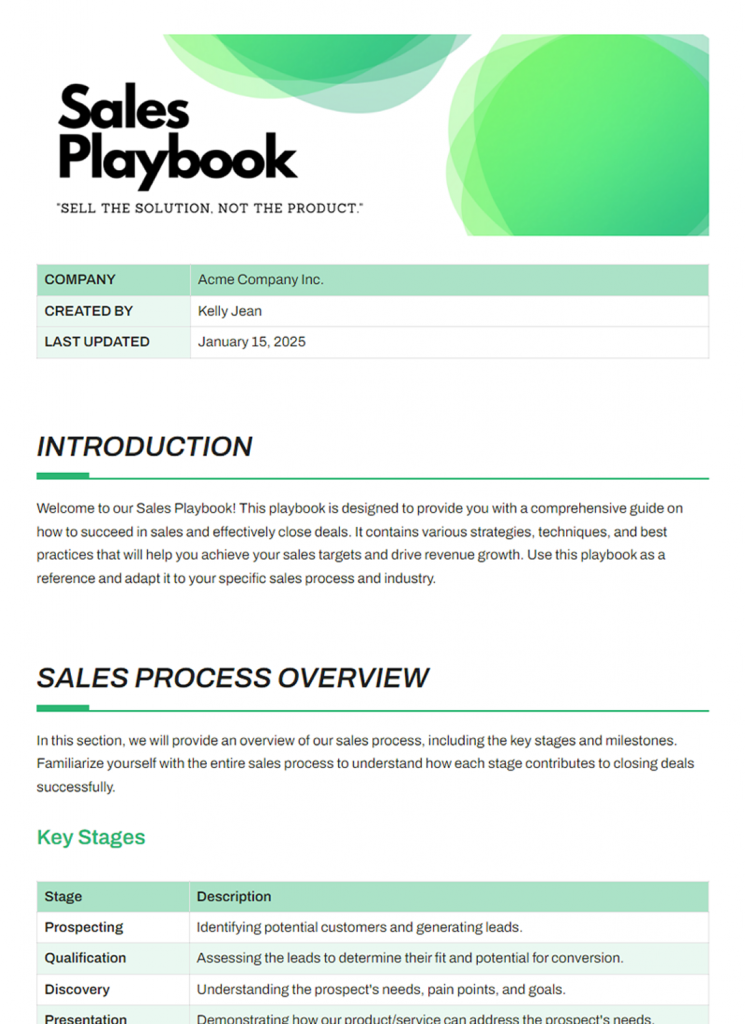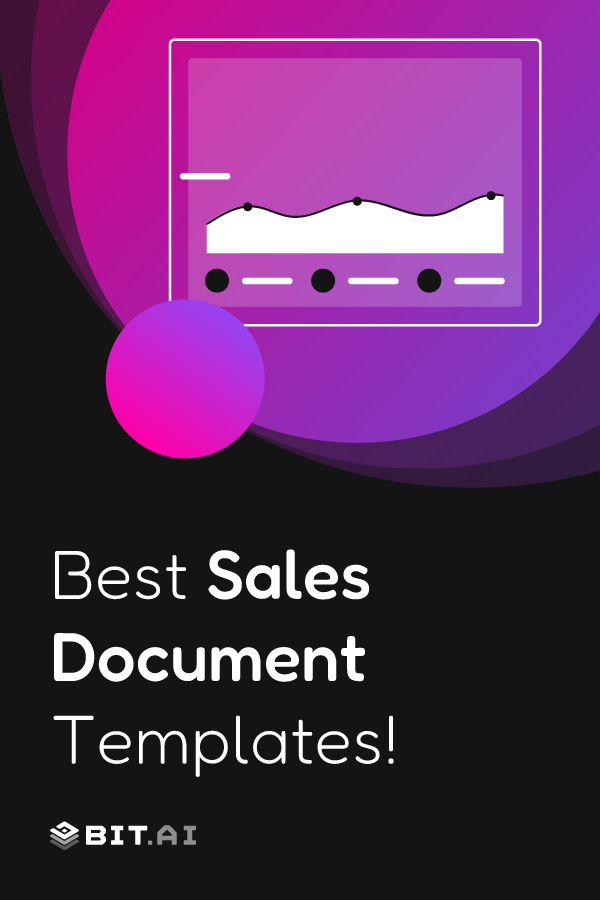Sales documents are essential tools in any successful sales strategy. They help communicate value, build credibility, and close deals. Having the right documents tailored to your company’s policies is crucial for maintaining a professional and effective sales process. These documents guide your sales team through every step, from prospecting and qualifying leads to handling objections and finalizing sales.
However, creating these documents from scratch can be time-consuming and challenging. With so many different types of sales documents needed—such as proposals, contracts, sales scripts, and call scripts—it can be overwhelming to know which ones to use and how to create them effectively. This is where having ready-made templates can save you significant time and effort.
Imagine having all the necessary sales document templates at your fingertips. You wouldn’t need to start from scratch each time you need a new document. Instead, you could quickly customize templates to fit your specific needs, allowing you to focus more on selling and less on paperwork.
To make your life easier, we’ve compiled a comprehensive list of essential sales document templates. Our collection includes everything you need to simplify your sales process and boost productivity. In our complete blog post, we’ll explore the importance of these documents in detail, discuss various types of sales documents, and offer free templates to help you succeed. So, read on!
What is Sales Documentation?
Sales documentation is a written guide that outlines the steps your sales reps should follow to close deals effectively. It covers every aspect of the sales process, like prospecting and qualifying leads, handling objections and finalizing the sale. This documentation is essential for ensuring that your sales team operates efficiently and consistently.
Your sales documentation benefits both experienced reps and new hires. For experienced ones, it serves as a refresher and a tool for maintaining consistency. For new hires, it provides a clear roadmap for learning the company’s sales processes. By following a structured process tailored to your business, you can ensure your customers receive a personalized experience.
Sales documents are vital information sources that support your sales pipeline. They help engage potential customers at various stages, providing guidance on how to move prospects through the sales funnel. By using sales documentation, you can increase your chances of winning more deals and building stronger customer relationships.
List of Top 20 Sales Document Types (Format and Templates Included)
Sales documents are essential for any sales team, regardless of the industry. These documents, covering sales strategy, operations, training, and customer relations, are crucial for winning new deals. We’ve gathered 20 must-have templates that will help you simplify your sales process and improve efficiency. Let’s explore these documents and understand why they are so important for your sales success.
Sales Strategy and Planning related Documents
1. Sales Strategy Plan
A sales strategy plan is a comprehensive document that outlines your company’s approach to selling its products or services. It helps guide your sales team on how to achieve their targets and drive revenue growth. This plan focuses on understanding the market, setting sales goals, and defining tactics to reach those goals. Key elements included in a sales strategy plan are:
- Executive Summary: A brief overview of the plan’s key points.
- Market Analysis: Understanding your target market, customer needs, and competitive landscape.
- Sales Goals: Specific, measurable objectives the sales teams aims to achieve.
- Target Customers: Detailed description of the ideal customer.
- Sales Tactics: Strategies and actions to reach sales goals (e.g., pricing, promotions, sales channels).
- Sales Process: Steps the sales team will follow to convert prospects into customers.
- Resources: Tools, technologies, and training needed for the sales team.
- Budget: Allocation of resources and funds to support the sales activities.
- KPIs and Metrics: Key Performance Indicators to track and measure success.
- Review and Adjustments: Regular evaluation and updates to the plan based on performance.
Read More: Sales Cycle: What is it and How To Build a Sales Process?
2. Sales Playbook
A sales playbook is a guidebook for your sales team, detailing best practices, strategies, and scripts for various selling scenarios. It serves as a practical resource to help sales reps easily engage with prospects and close deals. A sales playbook comprises of:
- Company Overview: Brief about your company, its products, and services.
- Buyer Personas: Detailed profiles of the target customers, including their needs and pain points.
- Sales Process: Step-by-step guide on the sales stages, from lead generation to closing.
- Sales Scripts: Predefined conversation scripts for different sales scenarios.
- Objection Handling: Techniques for addressing common customer objections.
- Value Proposition: Key messages that highlight the benefits of the product or service.
- Competitive Analysis: Insights on competitors and how to position against them.
- Case Studies and Testimonials: Real-life examples of successful sales and satisfied customers.
- Training Resources: Additional materials for ongoing sales training and development.
- Performance Metrics: Tools for tracking sales performance and success rates.


3. SOP (Standard Operating Procedure)
A standard operating procedure is a document that provides detailed, step-by-step instructions on how to perform specific tasks or processes. In sales, an SOP ensures consistency and efficiency in executing sales activities, leading to better results and compliance with your company policies. Add these elements while creating a SOP for sales:
- Title and Purpose: Name of the procedure and its objective.
- Scope: Description of the tasks or processes covered by the SOP.
- Responsibilities: Roles and responsibilities of team members involved.
- Procedure Steps: Detailed, sequential steps to complete the task or process.
- Tools and Resources: List of tools, software, and resources needed.
- Guidelines and Standards: Company policies and standards to be followed.
- Safety and Compliance: Any safety protocols or compliance requirements.
- Review and Updates: Schedule for regular review and updates of the SOP.
- Appendices and References: Additional supporting documents or reference materials.
4. Sales Forecast
Sales forecast is an essential document that estimates future sales revenue for a specific period. You use it to plan for resources, set targets, and make informed business decisions. It helps you predict how much product or service you will sell and when, allowing you to align your sales strategies and operations effectively. A sales forecast includes:
- Time Frame: The period for which the sales are being forecasted (e.g., monthly, quarterly, annually).
- Historical Data: Past sales data to help identify trends and patterns.
- Market Analysis: Insights into market conditions, industry trends, and economic factors.
- Sales Goals: Targets set for the sales team to achieve.
- Sales Pipeline: Current and potential deals in progress.
- Lead Generation: Expected number of leads and conversion rates.
- Assumptions: Assumptions made about market conditions, competition, and other factors.
- Revenue Projections: Estimated sales revenue for the forecast period.
- Adjustments: Consideration for seasonal variations, market changes, or new product launches.
- Review and Updates: Regular review and updating of the forecast based on actual sales performance.

5. KPI (Key Performance Indicators)
Key Performance Indicators (KPIs) are crucial metrics that help you measure the effectiveness of your sales strategies and operations. You use KPIs to track performance, identify areas for improvement, and ensure your team is on track to meet their goals. They provide clear, quantifiable data that reflect the success of your sales efforts. Here are the crucial elements of a KPI:
- Objective: The specific goal or purpose the KPI is designed to measure.
- Metric: The quantifiable measure used to track performance.
- Target: The desired level of performance to be achieved.
- Frequency: How often the KPI will be measured (e.g., daily, weekly, monthly).
- Source of Data: Where the data for the KPI will come from (e.g., CRM system, sales reports).
- Baseline: The current level of performance to compare against.
- Benchmark: Industry standards or competitor performance for comparison.
- Owner: The person or team responsible for the KPI.
- Reporting: How and when the KPI results will be reported.
- Action Plan: Steps to be taken based on the KPI results to improve performance.
6. KRA (Key Result Areas)
Key Result Areas (KRAs) are specific areas where you need to achieve significant results to meet your business objectives. KRAs help you focus on the critical aspects of your role that contribute most to the company’s success. They provide clarity on what is expected from you and align your efforts with the overall goals of the organization. Components included in a KRA document are:
- Objective: The main goal you aim to achieve within the KRA.
- Key Activities: Specific tasks and activities that will help achieve the objective.
- Performance Standards: Criteria for evaluating the success of each activity.
- Targets: Specific results or milestones to be reached.
- Timeline: The time frame within which the targets should be achieved.
- Resources: Tools, budget, and support needed to achieve the KRAs.
- Responsibilities: Who is responsible for each key activity.
- Measurement: How progress and success will be measured.
- Challenges: Potential obstacles and how to overcome them.
- Feedback: Regular check-ins to assess progress and make adjustments.
Sales Operations and Administration related Documents
7. Sales Pipeline
Sales Pipeline is a visual representation of where your prospects are in the sales process. You use it to track and manage potential sales opportunities from initial contact to closing the deal. This document helps you understand the stages your prospects go through and identify any bottlenecks in your sales process, allowing you to focus your efforts more effectively. Here’s what you typically include in a sales pipeline document:
- Stages: Different phases of the sales process (e.g., lead generation, qualification, proposal, negotiation, closing).
- Prospects: List of potential customers at each stage.
- Value: Estimated value of each potential deal.
- Probability: Likelihood of closing each deal.
- Timeline: Expected time frame to move from one stage to the next.
- Activities: Specific actions required to advance prospects to the next stage.
- Owner: Salesperson responsible for each prospect.
- Status Updates: Regular updates on the progress of each prospect.
- Next Steps: Immediate actions to be taken to move prospects forward.
8. Sales Activity Report
Sales Activity Report is a document that tracks the daily, weekly, or monthly activities of your sales team. You use it to monitor their efforts, identify trends, and ensure they are on track to meet their targets. This report helps you understand the quantity and quality of work being done and spot areas for improvement. When creating a sales activity report, you should include the following elements:
- Time Frame: Period covered by the report (daily, weekly, monthly).
- Activities Tracked: Types of activities being tracked (e.g., calls made, emails sent, meetings held).
- Salesperson: Name of each sales team member.
- Quantity: Number of activities completed.
- Quality: Assessment of the effectiveness of these activities.
- Lead Generation: Number of new leads generated.
- Conversion Rates: Percentage of activities that lead to new opportunities or closed deals.
- Performance Metrics: KPIs related to activity levels.
- Challenges: Any obstacles faced by the sales team.
- Recommendations: Suggestions for improving activity levels and effectiveness.

9. Sales Performance Review
Sales Performance Review is a document that evaluates the performance of your sales team over a specific period. You use it to assess how well your team is meeting their goals, provide feedback, and set new targets. This review helps you recognize top performers, identify areas for improvement, and plan for future success. Key elements in a sales performance review document include:
- Review Period: Time frame being evaluated.
- Sales Goals: Targets set for the review period.
- Achievements: Actual sales results compared to goals.
- Individual Performance: Assessment of each salesperson’s contributions.
- Strengths: Areas where the salesperson excels.
- Areas for Improvement: Specific aspects needing enhancement.
- Feedback: Comments and observations from supervisors.
- Training Needs: Identified training or development needs.
- Next Steps: Action plan for achieving future targets.
- Recognition: Acknowledgment of outstanding performance.
- Adjustments: Any changes to strategies or goals based on the review.
10. Sales Invoice
Managing sales operations efficiently requires proper documentation, and one of the most crucial documents is the sales invoice. A sales invoice serves as a formal request for payment from your client for the goods or services provided. It’s not just a tool for billing; it’s also essential for maintaining accurate financial records and ensuring smooth cash flow.
When you issue a sales invoice, you provide your clients with all the necessary details about their purchase, helping to avoid any confusion and ensuring timely payment. These invoices are fundamental in keeping your business transactions transparent and ensuring that both you and your clients have a clear understanding of the financial aspects of your dealings. When you create a sales invoice, it should include the following elements:
- Invoice Number: Unique identifier for tracking.
- Date of Issue: When the invoice was created.
- Due Date: When payment is expected.
- Seller’s Information: Your company’s name, address, and contact details.
- Buyer’s Information: Client’s name, address, and contact details.
- Description of Goods/Services: Detailed list of what was provided.
- Quantity and Price: Number of items and price per unit.
- Total Amount Due: Sum of all items, including taxes and discounts.
- Payment Terms: Conditions for payment, such as payment methods and late fees.
- Notes: Additional information or a thank you message.
11. Sales Quotation
Providing potential clients with a sales quotation is a crucial step in the sales process. This document gives an estimate of the costs for the products or services they are interested in. It helps set clear expectations and allows your clients to make informed purchasing decisions.
By presenting a well-structured sales quotation, you not only showcase your professionalism but also ensure that there are no surprises for the client regarding the costs involved. A sales quotation should typically include the following sections:
- Quotation Number: Unique identifier for tracking.
- Date of Issue: When the quotation was created.
- Validity Period: How long the quotation is valid.
- Seller’s Information: Your company’s name, address, and contact details.
- Buyer’s Information: Potential client’s name, address, and contact details.
- Description of Goods/Services: Detailed list of what is being offered.
- Quantity and Price: Number of items and price per unit.
- Total Estimated Cost: Sum of all items, including taxes and discounts.
- Terms and Conditions: Payment terms, delivery details, and other relevant policies.
- Notes: Additional information or clarifications.
12. Sales Commission Agreement
To motivate and reward your sales team, a well-defined sales commission agreement is essential. This document outlines the terms of compensation for your sales representatives, ensuring that both parties understand and agree on how commissions are earned and paid. By having a clear sales commission agreement, you can align the sales team’s efforts with your company’s goals and maintain a transparent compensation structure.
This agreement is vital for establishing a fair and motivating compensation plan that drives your sales team to achieve better results and contributes to the overall success of your business. Your sales commission agreement should cover the following aspects:
- Agreement Date: When the agreement was made.
- Parties Involved: Names and details of the company and the sales representative.
- Commission Structure: Detailed explanation of how commissions are calculated.
- Payment Terms: How and when commissions will be paid.
- Sales Targets and Goals: Specific targets the sales rep is expected to meet.
- Duration of Agreement: Time period the agreement covers.
- Termination Conditions: How and when the agreement can be ended.
- Confidentiality Clause: Ensuring business information remains protected.
- Signature Section: Spaces for both parties to sign and date.
Sales Enablement and Training related Documents
13. Sales Training Plan
A sales training plan is a guide that outlines the training activities designed to enhance the abilities of your sales team. By implementing a structured training plan, you can ensure consistency in training delivery, help new hires get up to speed quickly, and continually develop the skills of your existing team members. When you develop a sales training plan, consider including the following:
- Training Objectives: Clear goals that the training aims to achieve.
- Training Schedule: Timelines and dates for each training session.
- Content Outline: Topics and modules to be covered.
- Training Methods: Techniques and tools used, such as workshops, role-playing, or e-learning.
- Resources Needed: Materials and equipment required for the training.
- Assessment and Evaluation: Methods to measure the effectiveness of the training.
- Trainer Information: Details about the trainers, including their expertise.
- Participant List: Who will attend the training sessions.
- Follow-Up Activities: Actions to reinforce learning after the training sessions.
Read More: Create an Excellent Sales Playbook in 2025! (Steps Included)
14. Sales Call Scripts
Equipping your sales team with effective sales call scripts can greatly enhance their communication with potential clients. Sales call scripts provide a structured approach to conversations, helping your team stay on track, highlight key points, and respond to common objections confidently. With a well-prepared script, you can ensure consistency in messaging and increase the likelihood of successful calls. Your sales call scripts should have:
- Introduction: A brief, engaging way to start the call and introduce yourself.
- Opening Statement: An attention-grabbing sentence that sets the tone for the conversation.
- Key Questions: Specific questions to understand the client’s needs and pain points.
- Value Proposition: Clear explanation of how your product or service can solve the client’s problems.
- Handling Objections: Pre-prepared responses to common objections or concerns.
- Call to Action: What you want the client to do next, such as scheduling a meeting or making a purchase.
- Closing Statement: A polite and professional way to end the call, reinforcing the next steps.

15. Sales Emails
Crafting effective sales emails is an essential part of your sales strategy. Sales emails allow you to communicate with potential clients, nurture leads, and build relationships. Well-written sales emails can capture attention, convey your message clearly, and prompt recipients to take action. By following a structured format, you can create professional messages that engage recipients, ultimately helping you achieve your sales targets. When writing sales emails, include the following elements:
- Subject Line: Catchy and relevant to grab the recipient’s attention.
- Greeting: Personalized opening to address the recipient by name.
- Introduction: Briefly introduce yourself and your company.
- Body Content: Main message, including how your product or service can benefit the recipient.
- Call to Action: Clear instruction on what you want the recipient to do next.
- Closing: Polite and professional closing statement.
- Signature: Your contact information and any additional resources or links.
16. Sales Decks
A sales deck is a visual presentation that highlights your product or service’s value proposition, benefits, and key features. It helps you tell your story compellingly and persuasively, making it easier to engage potential clients and close deals. With a well-written sales deck, you can ensure your message is clear, professional, and impactful. A good sales deck comprises these sections:
- Introduction Slide: Briefly introduce your company and the purpose of the presentation.
- Problem Statement: Clearly define the problem your product or service solves.
- Solution Overview: Explain how your offering addresses the problem.
- Value Proposition: Highlight the unique benefits and advantages of your product or service.
- Product Features: Detailed description of key features and functionalities.
- Customer Testimonials: Quotes or case studies from satisfied customers.
- Market Analysis: Information about the market size and trends.
- Competitive Analysis: Comparison with competitors to show your strengths.
- Pricing Information: Overview of pricing plans or models.
- Call to Action: Clear next steps or actions you want your audience to take.
Read more: 20 Powerful Sales Deck Examples to Boost Your Pitch & Win Clients!
17. Pricing Sheet
Providing clear and detailed pricing information is crucial for any sales process, and that’s where a pricing sheet comes in. A pricing sheet outlines the costs associated with your products or services, helping potential clients understand what they will be paying for. It’s an essential tool for setting expectations and ensuring transparency in your sales transactions. By presenting your pricing clearly, you can avoid misunderstandings and build trust with your clients. Your pricing sheet should include:
- Product/Service Name: Clearly label each item being offered.
- Description: Brief explanation of what each product or service includes.
- Unit Price: Cost per unit of each product or service.
- Quantity: Number of units being purchased.
- Total Cost: Overall cost for each product or service.
- Discounts: Information on any available discounts or special offers.
- Additional Fees: Any extra charges, such as shipping or handling fees.
- Payment Terms: Conditions regarding payment methods and due dates.
- Contact Information: How clients can reach you for questions or clarifications.
Customer Relations and Case Studies related Documents
18. Customer Case Studies
Showcasing real-world success is a powerful way to build trust and credibility with potential clients. Customer case studies are detailed accounts of how your product or service has successfully helped a client solve a specific problem or achieve a goal.
They provide concrete evidence of your product’s effectiveness and offer a persuasive tool for convincing new customers to choose your solutions. By highlighting real-life examples, you make your offerings more relatable and trustworthy. While creating a customer case study, you must focus on :
- Client Information: Brief background of the customer.
- Problem Statement: Description of the challenge the client faced.
- Solution: Explanation of how your product or service addressed the problem.
- Implementation: Details on how the solution was implemented.
- Results: Quantitative and qualitative outcomes achieved.
- Customer Quotes: Testimonials from the client.
- Visuals: Images, graphs, or charts illustrating the process and results.
- Conclusion: Summary of the case study and its impact.
- Call to Action: Encouragement for the reader to contact you for similar results.
Read More: Sales Sheet: What is it & How to Create it? (Steps Included)
19. Sales Proposal
A sales proposal is a formal document that outlines how your product or service will meet the client’s needs, including the proposed solution, benefits, and costs. Convincing potential clients to choose your solutions often requires a comprehensive and persuasive sales proposal. It serves as a detailed pitch that helps potential customers understand the value you offer and how you plan to deliver it.
By presenting a well-structured sales proposal, you can clearly communicate your value proposition and increase your chances of winning new business. To create an effective sales proposal, focus on these elements:
- Executive Summary: Brief overview of the proposal’s main points.
- Client Needs: Detailed understanding of the client’s challenges and needs.
- Proposed Solution: Description of how your product or service will address these needs.
- Benefits: Key advantages and value your solution offers.
- Implementation Plan: Steps and timeline for delivering the solution.
- Pricing: Detailed cost breakdown of your offering.
- Terms and Conditions: Legal and operational terms of the agreement.
- Company Information: Background and credentials of your business plan.
- Contact Information: How the client can reach you for further discussions.
20. Sales Contract
Finalizing a sale requires a clear and legally binding agreement, which is where a sales contract comes in. A sales contract outlines the terms and conditions of the sale, ensuring both parties understand their obligations and rights. This document is crucial for protecting both you and your client, providing a clear framework for the transaction, and reducing the risk of misunderstandings. When drafting a sales contract, ensure it includes these sections:
- Parties Involved: Names and contact information of the buyer and seller.
- Description of Goods/Services: Detailed description of what is being sold.
- Price and Payment Terms: Agreed-upon price and payment schedule.
- Delivery Terms: How and when the goods or services will be delivered.
- Warranties: Any guarantees provided by the seller.
- Liabilities: Responsibilities and liabilities of both parties.
- Termination Conditions: Terms under which the contract can be terminated.
- Signatures: Signatures of both parties to make the contract legally binding.
Conclusion
So, there you have it – we’ve explored what sales documents are and discussed 20 essential sales document templates. These documents are crucial for a smooth sales process, helping you establish trust and credibility with customers while providing a clear roadmap for closing deals. By using these templates, you can save time and present your company in the best possible light.
Remember to customize sales document templates to fit your brand and regularly update them to reflect changes in your sales strategy.
Now, go ahead and use these sales document templates to make your sales process more efficient and effective. Happy selling!
Further Reads:
- Sales Process: What is it & How To Create a Document for it? (Template Included)
- Best Sales Productivity Strategies That Drive Sales!
- 40 Selling Words & Phrases To Sell Your Product and Services!
- 12 Sales KPIs Your Sales Department Should Measure!


